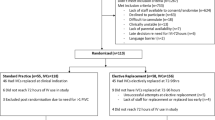Abstract
Objective:
To compare the occurrence of systemic infection or death in preterm infants with elective percutaneous central line (PCVL) placement versus peripheral intravenous catheter (PIV) placement.
Study design:
A total of 96 infants ⩽1250 g or ⩽30 weeks gestation were randomized by 4 days of age to elective placement of a PCVL or continued use of PIV catheters. The primary outcome of systemic infection (defined as a positive blood or cerebrospinal fluid (CSF) culture treated for at least 5 days) or death was monitored until the infants did not require intravenous (iv) support for 7 consecutive days.
Results:
Systemic infection or death occurred in 17/46 (39%) infants in the PCVL group and 14/50 (28%) in the PIV group (relative risk (RR)=1.32 with 95% confidence interval (CI) 0.70, 2.53; risk difference (RD)=0.09 with 95% CI −0.10, 0.28). The PCVL group had significantly fewer skin punctures for iv access.
Conclusion:
There was no significant difference in systemic infection or death (expressed either as a combined outcome or as separate component outcomes) between the groups. The number of skin punctures was significantly reduced in the PCVL group.
Access this article
We’re sorry, something doesn't seem to be working properly.
Please try refreshing the page. If that doesn't work, please contact support so we can address the problem.
Similar content being viewed by others
References
Stoll BJ, Hansen N, Fanaroff AA, Wright LL, Carlo WA, Ehrenkranz RA et al. Late-onset sepsis in very low birth weight neonates: the experience of the NICHD neonatal research network. Pediatrics 2002; 110: 285–291.
Janes M, Kalyn A, Pinelli J, Paes B . A randomized trial comparing peripherally inserted central venous catheters and peripheral intravenous catheters in infants with very low birth weight. J Pediat Surg 2000; 35: 1040–1044.
Ainsworth SB, Furness J, Fenton AC . Randomized comparative trial between percutaneous longlines and peripheral cannulae in the delivery of neonatal parenteral nutrition. Acta Paediatr 2001; 90: 1016–1020.
Annibale DJ, Bissinger RL, Hulsey TC, Headdon P, Ohning BL . Early percutaneous central venous catheterization (PCVC) in neonates. Pediatr Res 1995; 37: 194A.
Ainsworth SB, Clerihew L, McGuire W . Percutaneous central venous catheters versus peripheral cannulae for delivery of parenteral nutrition in neonates [review]. The Cochrane Library 2004; 2: 1–13.
Shulz KF, Grimes DA . Sample size calculations in randomized trials: mandatory and mystical. Lancet 2005; 365: 1348–1353.
Garland JS, Henrickson K, Maki DG . 2002 Hospital infection control practices advisory committee centers for disease control and prevention. The 2002 hospital infection control practices advisory committee centers of disease control and prevention guideline for prevention of intravascular device-related infection. Pediatrics 2002; 110: 1009–1013.
Trotter CW . A national survey of percutaneous central venous catheter practices in neonates. Neonatal Network 1998; 17: 31–38.
Golombek SG, Rohan AJ, Parvez B, Salice AL, LaGamma EF . ‘Proactive’ management of percutaneously inserted central catheters results in decreased incidence of infection in the ELBW population. J Perinatol 2002; 22: 209–213.
Puchalski M, Hummel P . The reality of neonatal pain. Adv Neonatal Care 2002; 2: 233–244.
Grunau R . Early pain in preterm infants. A model of long-term effects. Clin Perinatol 2002; 29: 373–394.
Pettit J . Assessment of infants with peripherally inserted central catheters: part 1. Detecting the most frequent occurring complications. Adv Neonatal Care 2002; 2: 304–315.
Beardsall S, White DK, Pinto EM, Kelsall AWR . Pericardial effusion and cardiac tamponade as complications of neonatal long lines: are they really a problem? Arch Dis Child Fetal Neonatal Ed 2003; 88: F292–F295.
Cartwright DW . Central venous lines in neonates: a study of 2186 catheters. Arch Dis Child Fetal Neonatal Ed 2004; 89: F504–F508.
Acknowledgements
We thank the physicians, staff, Neonatal Transport Team members and parents for their help and support during this study.
Author information
Authors and Affiliations
Corresponding author
Rights and permissions
About this article
Cite this article
Wilson, D., Verklan, M. & Kennedy, K. Randomized trial of percutaneous central venous lines versus peripheral intravenous lines. J Perinatol 27, 92–96 (2007). https://doi.org/10.1038/sj.jp.7211650
Received:
Revised:
Accepted:
Published:
Issue Date:
DOI: https://doi.org/10.1038/sj.jp.7211650
- Springer Nature America, Inc.
Keywords
This article is cited by
-
Prävention von Infektionen, die von Gefäßkathetern ausgehen
Bundesgesundheitsblatt - Gesundheitsforschung - Gesundheitsschutz (2017)
-
Peripheral insertion of double-lumen central venous catheter using the Seldinger technique in newborns
Journal of Perinatology (2008)




